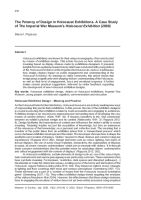The Potency of Design in Holocaust Exhibitions. A Case Study of The Imperial War Museum’s Holocaust Exhibition (2000)
Author(s)
Publication Name
Publication Date
Abstract
Holocaust exhibitions are known for their unique iconography, often constructed by means of exhibition design. This article focuses on how visitors construct meaning based on display choices made by exhibitions designers. It presents insights from an audience research study which was conducted with young visitors of The Holocaust Exhibition at the Imperial War Museum in London. It addresses how design choices impact on the visitor’s engagement and understanding of the Holocaust Exhibition. By drawing on visitor comments, this article shows that design plays a significant role in shaping visitors’ understanding of the Holocaust, as well as their level of engagement, focus and emotional response. It further makes several practical suggestions, informed by visitor feedback, regarding the development of new Holocaust exhibition designs.
Topics
Genre
Geographic Coverage
Copyright Info
This work is licensed under a Creative Commons Attribution-NonCommercial-NoDerivatives 4.0 International License.
We use both functional and performance cookies to improve visitor experience. Continue browsing if you are happy to accept cookies. Please see our Privacy Policy for more information.
OK
We use both functional and performance cookies to improve visitor experience. Continue browsing if you are happy to accept cookies. Please see our Privacy Policy for more information.
OK
Original Language
Volume/Issue
18(2)
Page Number / Article Number
218-242
DOI
Link
Link to article including link to pdf, The Potency of Design in Holocaust Exhibitions. A Case Study of The Imperial War Museum’s Holocaust Exhibition (2000)
Bibliographic Information
The Potency of Design in Holocaust Exhibitions. A Case Study of The Imperial War Museum’s Holocaust Exhibition (2000). 2020: 218-242. https://archive.jpr.org.uk/10.29311/mas.v18i2.3357




